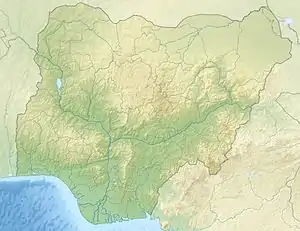Kainji Dam
Kainji Dam is a dam across the Niger River in Niger State of Central Nigeria. Construction of the dam was carried out by Impregilo (a consortium of Italian Civil Engineering Contractors) to designs by Joint Consultants, Balfour Beatty and Nedeco, and began in 1964 to be completed in 1968. The total cost was estimated at US$209 million (equivalent to about US$1.3 billion in 2019 dollars[1]), with one-quarter of this amount used to resettle people displaced by the construction of the dam and its reservoir, Kainji Lake.
| Kainji Dam | |
|---|---|
 Map of Nigeria showing the location of Kainji Dam. | |
| Location | Kainji, Niger, Nigeria |
| Coordinates | 09°51′45″N 04°36′48″E |
| Construction began | 1964 |
| Opening date | 1968 |
| Construction cost | US$209 million |
| Owner(s) | Federal Government of Nigeria |
| Operator(s) | Mainstream Energy |
| Dam and spillways | |
| Impounds | Niger River |
| Height | 65 m (213 ft) |
| Length | 550 m (1,804 ft) |
| Reservoir | |
| Creates | Kainji Lake |
| Power Station | |
| Commission date | 1968 |
| Turbines | 8 |
| Installed capacity | 760 megawatts (1,020,000 hp) 960 megawatts (1,290,000 hp) (max) |
Dimensions
Kainji Dam extends for about 10 kilometres (6.2 mi), including its saddle dam, which closes off a tributary valley. The primary section across the outflow to the Niger is 550 metres (1,800 ft). Most of the structure is made from earth, but the centre section, housing the hydroelectric turbines, was built from concrete. This section is 65 metres (213 ft) high. Kanji Dam is one of the longest dams in the world.[2]
Power station
The dam was designed to have a generating capacity of 960 megawatts (1,290,000 hp); however, only 8 of its 12 turbines have been installed, reducing the capacity to 760 megawatts (1,020,000 hp).[3] The dam generates electricity for all the large cities in Nigeria. Some of the electricity is sold to the neighbouring country of Niger. In addition, occasional droughts have made the Niger's water flow unpredictable, diminishing the dam's electrical output.
 Flow of water through four openings in the Kainji Dam, 1970–1973.
Flow of water through four openings in the Kainji Dam, 1970–1973. Overview from the dam of the island in the Niger River with electricity pylons, 1970–1973.
Overview from the dam of the island in the Niger River with electricity pylons, 1970–1973. Zebus crossing the dam, 1970–1973.
Zebus crossing the dam, 1970–1973. A shepherd boy at the dam, 1970–1973.
A shepherd boy at the dam, 1970–1973. Man above the foaming water, 1970–1973.
Man above the foaming water, 1970–1973.
Lock
The dam has a single-lock chamber capable of lifting barges 49 metres (161 ft).
Discharge flooding
In October 1998 in response to upstream flooding, a torrent of water was released from the dam, bursting the river banks. Downstream from the dam 60 villages were flooded. Domestic animals drowned and dikes as well as several farms were washed away. Dam officials were criticized for waiting too long before starting, then dumping too much water.[4]
Lake Kainji
Kainji Lake measures about 135 kilometres (84 mi) long and about 30 kilometres (19 mi) at its widest point, and supports irrigation and a local fishing industry.[5] In 1999, uncoordinated opening of floodgates led to local flooding of about 60 villages.[6]
References
- Thomas, Ryland; Williamson, Samuel H. (2020). "What Was the U.S. GDP Then?". MeasuringWorth. Retrieved September 22, 2020. United States Gross Domestic Product deflator figures follow the Measuring Worth series.
- "An inside look at Kainji Dam". Daily Trust Online. Archived from the original on October 14, 2012. Retrieved July 21, 2012.
- "An inside look at Kainji Dam". Daily Trust Online. Archived from the original on October 14, 2012. Retrieved July 18, 2012.
- "The dam which brought disaster". 2009-07-26. Archived from the original on 2009-07-26. Retrieved 2020-02-07.
- "Tajikistan to Export Electricity to Afghanistan". Encyclopædia Britannica. Retrieved July 18, 2012.
- "Archived copy". Archived from the original on 2009-07-26. Retrieved 2008-06-09.CS1 maint: archived copy as title (link)